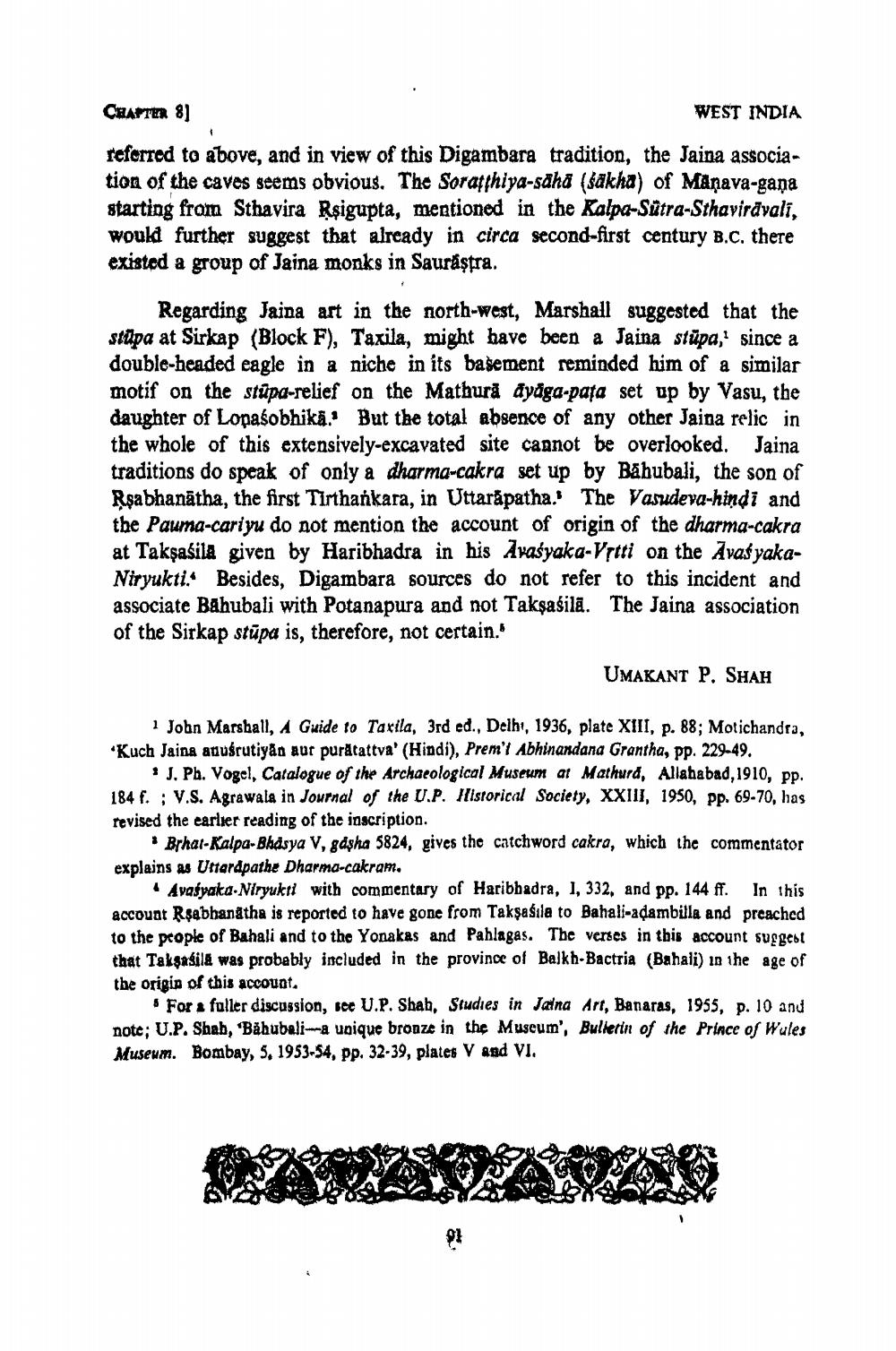________________
CHAPTER 8]
WEST INDIA
referred to above, and in view of this Digambara tradition, the Jaina association of the caves seems obvious. The Soratthiya-sähä (säkha) of Manava-gana starting from Sthavira Rsigupta, mentioned in the Kalpa-Sütra-Sthaviravalī, would further suggest that already in circa second-first century B.C. there existed a group of Jaina monks in Saurăştra.
Regarding Jaina art in the north-west, Marshall suggested that the stupa at Sirkap (Block F), Taxila, might have been a Jaina stupa, since a double-headed eagle in a niche in its basement reminded him of a similar motif on the stupa-relief on the Mathurā āyāga-pata set up by Vasu, the daughter of Lopaśobhika. But the total absence of any other Jaina relic in the whole of this extensively-excavated site cannot be overlooked. Jaina traditions do speak of only a dharma-cakra set up by Bahubali, the son of Rṣabhanatha, the first Tirthankara, in Uttarapatha.' The Vasudeva-hindi and the Pauma-cariyu do not mention the account of origin of the dharma-cakra at Takşaśila given by Haribhadra in his Avasyaka-Vṛtti on the AvasyakaNiryukti. Besides, Digambara sources do not refer to this incident and associate Bahubali with Potanapura and not Takşaśila. The Jaina association of the Sirkap stupa is, therefore, not certain."
UMAKANT P. SHAH
1 John Marshall, A Guide to Taxila, 3rd ed., Delhi, 1936, plate XIII, p. 88; Motichandra, 'Kuch Jaina anuśrutiyān aur purătattva' (Hindi), Prem't Abhinandana Grantha, pp. 229-49.
J. Ph. Vogel, Catalogue of the Archaeological Museum at Mathurd, Allahabad, 1910, pp. 184 f.; V.S. Agrawala in Journal of the U.P. Historical Society, XXIII, 1950, pp. 69-70, has revised the earlier reading of the inscription.
* Brhat-Kalpa-Bhasya V, gdsha 5824, gives the catchword cakra, which the commentator explains as Uttardpathe Dharma-cakram.
▲ Avasyaka-Niryukti with commentary of Haribhadra, 1, 332, and pp. 144 ff. In this account Rṣabhanatha is reported to have gone from Takşašila to Bahali-adambilla and preached to the people of Bahali and to the Yonakas and Pahlagas. The verses in this account suggest that Takṣasila was probably included in the province of Balkh-Bactria (Bahali) in the age of the origin of this account.
For a fuller discussion, see U.P. Shah, Studies in Jaina Art, Banaras, 1955, p. 10 and note; U.P. Shah, 'Bahubali-a unique bronze in the Museum', Bulletin of the Prince of Wales Museum. Bombay, 5, 1953-54, pp. 32-39, plates V and VI.
H




